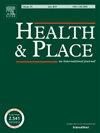Exploring sex differences in the longitudinal association between streetlighting and transport walking
IF 3.8
2区 医学
Q1 PUBLIC, ENVIRONMENTAL & OCCUPATIONAL HEALTH
引用次数: 0
Abstract
Regular physical activity, such as transport walking, is essential for health, yet many adults do not meet recommended physical activity levels. The built environment, particularly streetlighting, plays a critical role in promoting transport walking. However, existing evidence on the relationship between streetlighting and transport walking is largely cross-sectional, with limited longitudinal research exploring potential sex differences. This study aimed to assess the longitudinal association between objectively measured streetlight count and transport walking among mid-to-older-aged adults in Brisbane, Australia, and to explore whether this association varies by sex. Data were from the How Areas in Brisbane Influence HealTh and AcTivity (HABITAT) study, a multilevel cohort study with five waves over nine years (2007–2016). The analytical sample included participants who did not move during the study. Transport walking was self-reported and dichotomized into walkers and non-walkers. Streetlight counts within a 1 km road network buffer around participants’ homes were measured alongside transport walking. Generalized linear mixed-effects models were used, adjusting for sociodemographic factors, length of stay, neighbourhood preference, and built environment attributes. Higher streetlight counts were positively associated with transport walking (OR 1.002; 95% CI 1.001, 1.002), and the association remained significant after adjusting for residential density, street connectivity, and land-use mix. No significant sex differences were found. This study provides longitudinal evidence that well-lit environments promote transport walking among mid-to-older-aged adults. This finding can inform urban planning and public health policies aimed at encouraging transport walking to help reduce the risk of chronic disease.
求助全文
约1分钟内获得全文
求助全文
来源期刊

Health & Place
PUBLIC, ENVIRONMENTAL & OCCUPATIONAL HEALTH-
CiteScore
7.70
自引率
6.20%
发文量
176
审稿时长
29 days
期刊介绍:
he journal is an interdisciplinary journal dedicated to the study of all aspects of health and health care in which place or location matters.
 求助内容:
求助内容: 应助结果提醒方式:
应助结果提醒方式:


